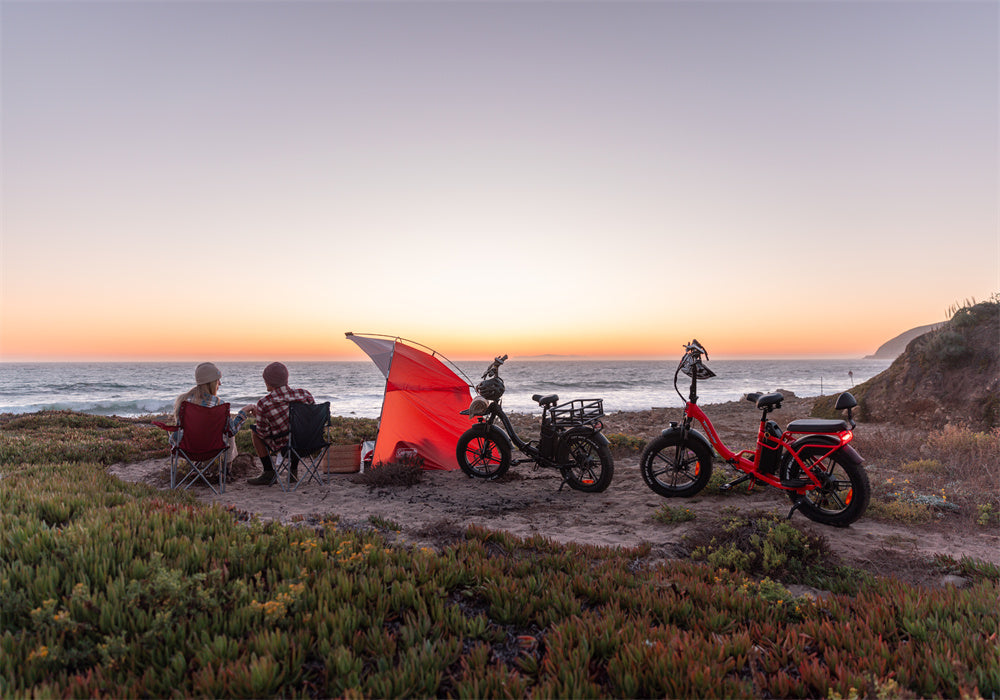Electric bikes have surged in popularity as a versatile, eco-friendly transportation option. One of the most critical factors potential ebike owners consider is the bike's range – essentially, how far can it go on a single charge? This comprehensive guide delves into what ebike range is, how it's calculated, factors affecting it, and tips to extend it.
What is the Electric Bike Range?
The ebike range refers to the distance an electric bike can travel on a single charge of its battery. This range varies significantly depending on various factors, including the type of ebike, battery capacity, motor efficiency, terrain, rider weight, and more. Generally, ebike ranges can span from 20 miles to over 100 miles per charge.
Battery Capacity: Measured in watt-hours (Wh), battery capacity is a crucial determinant of the range. A higher Wh indicates a larger capacity, which typically translates to a longer range.
Motor Power: The power of the motor, measured in watts (W), also impacts the range. Higher power motors may consume more battery power, potentially reducing the range.
Pedal Assist Levels: Ebikes often come with multiple levels of pedal assist. Using a higher level of assistance can decrease the range, while a lower level can extend it.

Different Types of Ebikes and Their Range Expectations
Ebikes come in various styles, each designed for specific purposes, and their range can vary widely. Here's a detailed look at different types of ebikes and their typical range expectations.
Commuter Ebikes
Commuter ebikes are designed for daily use, such as getting to work or running errands around town. They typically have a balance of battery capacity and motor power to provide a reliable range.
-
Typical Range: 20-50 miles per charge
-
Features: Often include integrated lights, racks, and fenders for convenience and safety.
- Best For: Urban environments and daily commuting.
Mountain Ebikes
Mountain ebikes are built for off road adventures, featuring robust motors and large batteries to tackle challenging terrains.
-
Typical Range: 20-70 miles per charge
-
Features: Equipped with durable frames, suspension systems, and knobby tires for handling rough trails.
- Best For: Offroad trails, mountainous regions, and rugged terrains.

Touring Ebikes
Touring ebikes are designed for long distance travel, offering extended range and comfort for multi-day trips.
-
Typical Range: 50-100+ miles per charge
-
Features: Larger battery capacity, comfortable seating, and provisions for carrying luggage.
- Best For: Long distance rides, bikepacking, and touring.
Folding Ebikes
Folding ebikes are compact and portable, making them ideal for urban commuters who need to carry their bike onto public transport or store it in small spaces.
-
Typical Range: 15-30 miles per charge
-
Features: Foldable frame, lightweight design, and smaller wheels.
- Best For: Urban commuting, limited storage spaces, and combining with public transportation.
Cargo Ebikes
Cargo ebikes are designed to carry heavy loads, making them ideal for families, delivery services, or anyone needing to transport goods.
-
Typical Range: 20-40 miles per charge
-
Features: Sturdy frames, large cargo areas, and high-capacity batteries.
- Best For: Hauling groceries, kids, or deliveries.
Hybrid Ebikes
Hybrid ebikes combine features from road and mountain bikes, offering versatility for both urban commuting and light off road use.
-
Typical Range: 30-60 miles per charge
-
Features: Comfortable geometry, moderate tire treads, and adaptable components.
- Best For: Mixed terrain, commuting, and recreational riding.

Key Factors Influencing Ebike Range
The driving range of an electric bicycle is influenced by several key factors.
Battery Size and Quality
Terrain and Riding Conditions
Rider Weight and Load
Riding Style
Tire Pressure and Type
Properly inflated tires reduce rolling resistance, enhancing efficiency and range.
Different tire types, such as those designed for road versus off road, can also affect how far you can travel.

How Do You Estimate the Range of an Ebike?
Estimating the range of an ebike involves considering various factors and using specific formulas to get a clearer picture of how far you can expect to go on a single charge. Here’s a detailed look at how you can estimate your ebike's range.
Basic Formula for Estimating Ebike Range
A common formula used to estimate ebike range is:
For example, if your ebike has a 500Wh battery and the average power consumption is 20Wh per mile, the estimated range would be:
Range=20 Wh/mile500 Wh=25 miles
Factors in the Calculation
-
Battery Capacity (Wh): This is the product of voltage (V) and ampere-hours (Ah). For instance, a 36V battery with 14Ah capacity equals 504Wh.
- Average Power Consumption (W per mile): This can vary based on riding conditions, assist level, and other factors. For general use, it might range from 15-25Wh per mile.
Practical Example of Range Calculation
Consider an ebike with a 48V, 10Ah battery:
- Battery Capacity:
- Average Consumption: Assuming 20Wh per mile
Using the formula:
This estimate can be fine-tuned based on specific riding conditions and habits.

Tips for Increasing the Range of Electric Bicycles
Maximizing the range of your electric bicycle ensures you get the most out of your rides without worrying about running out of battery.
Optimize Your Riding Style
- Use Pedal Assist Wisely: Lower pedal assist levels consume less power. Use higher levels only when necessary, like climbing hills.
- Maintain a Steady Pace: Avoid rapid acceleration and maintain a consistent speed to reduce power consumption.
- Plan Your Route: Choose routes with fewer hills and smoother paths to conserve energy.
Maintain Your Ebike Properly
- Regular Battery Maintenance: Keep your battery charged and store it properly. Avoid extreme temperatures that can degrade battery performance.
- Tire Maintenance: Keep your tires properly inflated to reduce rolling resistance. Check for wear and replace tires as needed.
- Motor and Drive System: Ensure the motor and drivetrain are clean and well-lubricated to operate efficiently.
Minimize Extra Weight
- Lighten Your Load: Carry only essential items to reduce the weight the motor has to move.
- Choose Lightweight Accessories: Opt for lighter accessories and components to help extend the range.
Enhance Aerodynamics
- Streamline Your Gear: Wear fitted clothing and minimize items that increase drag.
- Bike Position: Adjust your riding position to be more aerodynamic, reducing resistance and conserving battery power.
You Need to Buy a Long Distance Electric Bike?
Looking for an electric bike that can go the distance? Check out TESWAY's long distance electric bicycles, especially the S5pro. With a powerful 750w motor and a load bearing capacity of 330 lbs, the S5pro can reach up to 90 miles on a single charge. If you're in the market for a reliable long distance electric bike, TESWAY is the perfect choice for you!
FAQs
How does terrain impact ebike range?
Riding on hilly or uneven terrain requires more power, which can decrease the range compared to riding on flat, smooth surfaces.
Can weather conditions affect my ebike's range?
Yes, extreme temperatures, wind, and rain can impact battery performance and efficiency, affecting the range.
What is the best way to charge my ebike to maximize range?
Charge your ebike battery fully and avoid letting it drain completely. Store the battery in a cool, dry place and avoid exposure to extreme temperatures.







Share:
Hardtail vs. Full-Suspension Electric Bikes – Which One Should You Choose?
7 Best Electric Bikes for Adults in the US | We have Tested